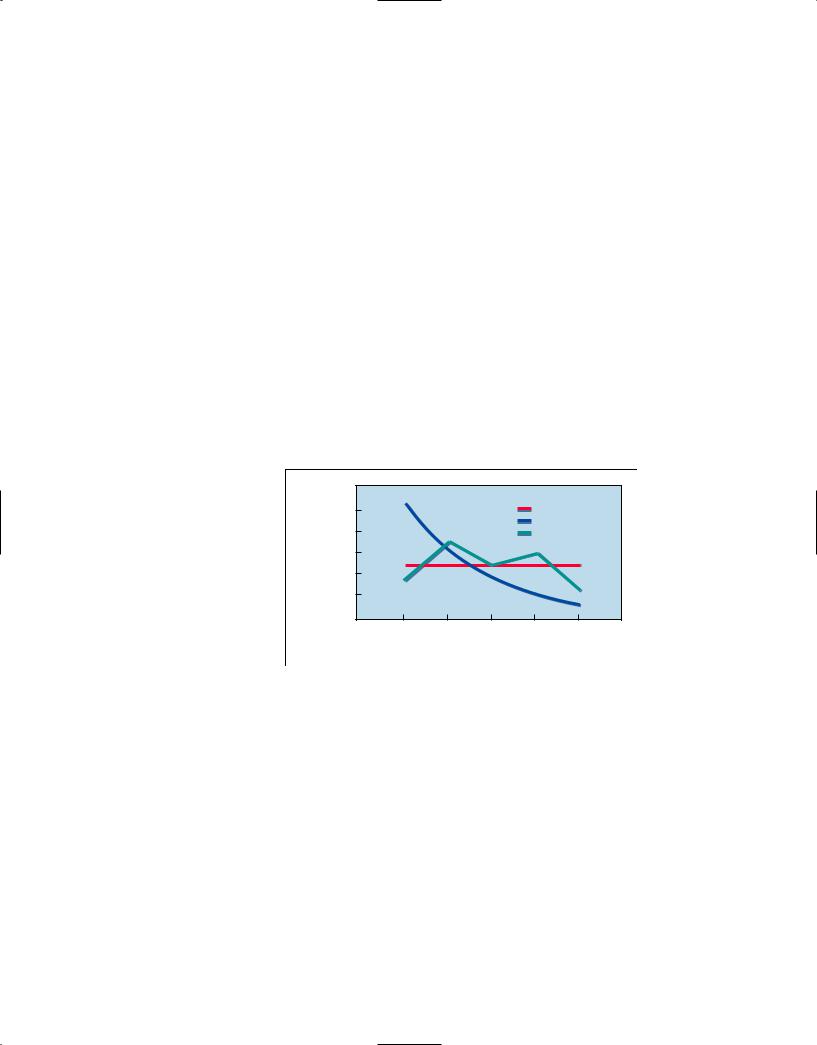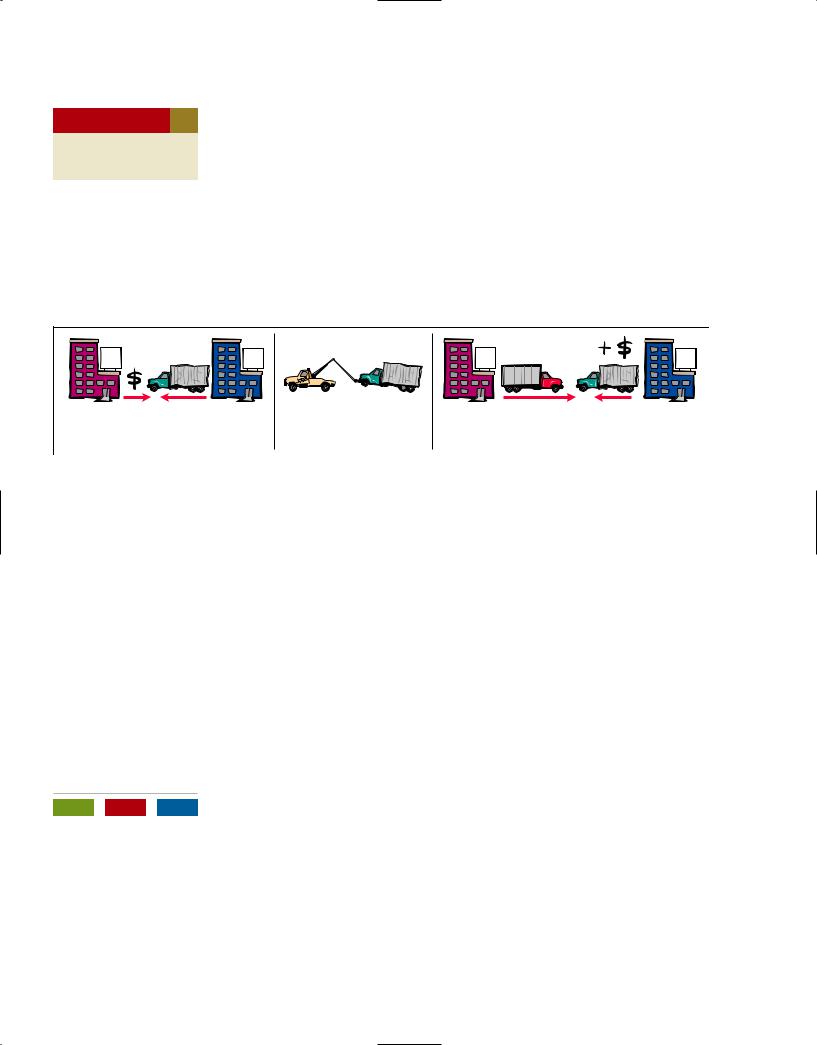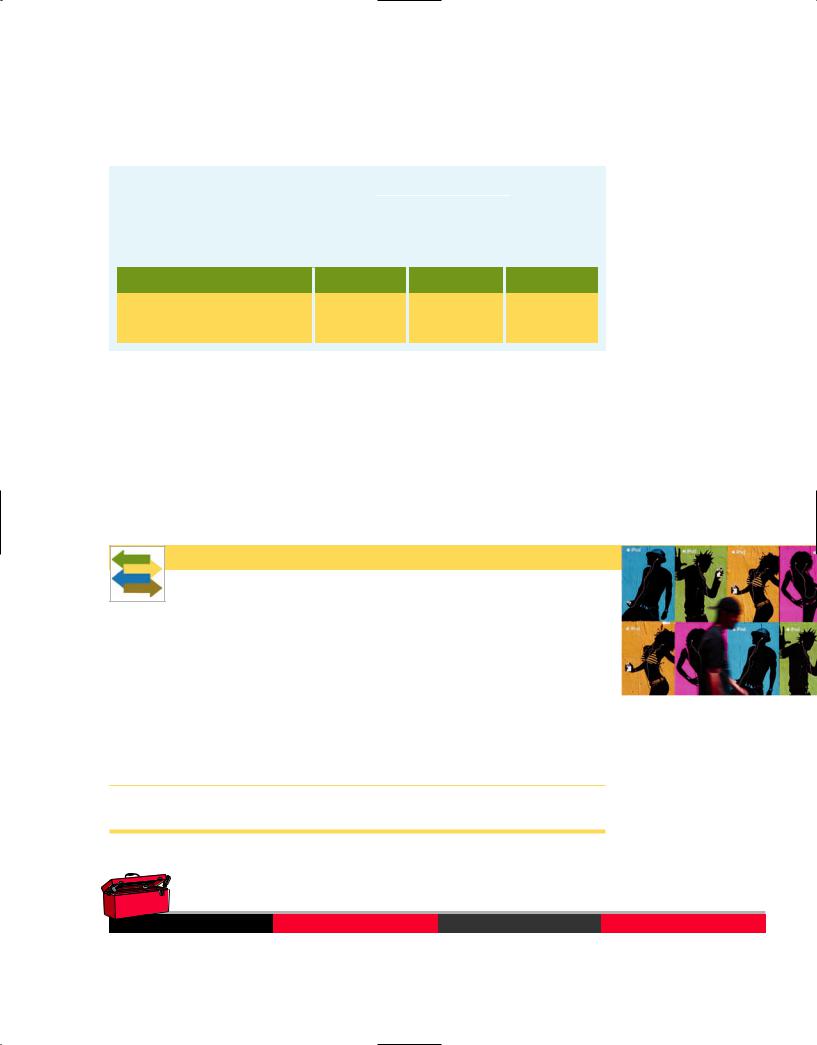380
458 chapter 9 Reporting and Analyzing Long-Lived Assets
Management’s Choice: Comparison of Methods
Illustration 9-12 compares annual and total depreciation expense for Bill’s Pizzas under the three methods.
Illustration 9-12 |
|
Straight- |
Declining- |
Units-of- |
Comparison of |
|
Year |
|
|
|
Line |
|
|
Balance |
|
Activity |
|
depreciation methods |
|
|
|
|
|
|
|
2012 |
$ |
2,400 |
|
$ 5,200 |
$ 1,800 |
|
|
2013 |
|
|
|
2,400 |
|
3,120 |
3,600 |
|
|
2014 |
|
|
|
2,400 |
|
1,872 |
2,400 |
|
|
2015 |
|
|
|
2,400 |
|
1,123 |
3,000 |
|
|
2016 |
|
|
|
2,400 |
|
|
685 |
1,200 |
|
|
|
|
|
|
|
|
|
|
|
|
|
|
|
$12,000 |
|
$12,000 |
$12,000 |
|
|
|
|
|
|
|
|
|
|
|
|
|
|
|
Periodic depreciation varies considerably among the methods, but total depreciation is the same for the five-year period. Each method is acceptable in accounting because each recognizes the decline in service potential of the asset in a rational and systematic manner. Illustration 9-13 graphs the depreciation expense pattern under each method.
Illustration 9-13 Patterns of depreciation
Expense |
|
|
|
Key: |
|
$5,000 |
|
|
Straight-line |
$4,000 |
|
|
Declining-balance |
|
|
Units-of-activity |
Depreciation |
$3,000 |
|
|
|
|
$2,000 |
|
|
|
|
$1,000 |
|
|
|
|
0 |
|
|
|
|
|
|
|
|
|
|
2012 |
2013 |
2014 |
2015 |
2016 |
|
|
|
Year |
|
|
Helpful Hint Depreciation per financial statements is usually different from depreciation per tax returns.
Depreciation and Income Taxes
The Internal Revenue Service (IRS) allows corporate taxpayers to deduct depreciation expense when computing taxable income. However, the tax regulations of the IRS do not require the taxpayer to use the same depreciation method on the tax return that it uses in preparing financial statements.
Consequently, many large corporations use straight-line depreciation in their financial statements in order to maximize net income; at the same time, they use a special accelerated-depreciation method on their tax returns in order to minimize their income taxes. For tax purposes, taxpayers must use on their tax returns either the straight-line method or a special accelerated-depreciation method called the Modified Accelerated Cost Recovery System (MACRS).
Depreciation Disclosure in the Notes
Companies must disclose the choice of depreciation method in their financial statements or in related notes that accompany the statements. Illustration 9-14 shows excerpts from the “Property and equipment” notes from the financial statements of Southwest Airlines.
381
|
|
|
Accounting for Plant Assets 459 |
|
|
|
|
Illustration 9-14 |
|
|
|
|
|
|
SOUTHWEST AIRLINES |
|
|
|
|
Disclosure of depreciation |
|
|
Notes to the Financial Statements |
|
policies |
|
|
|
|
|
|
|
|
|
|
Property and equipment Depreciation is provided by the straight-line method to estimated residual values over periods ranging from 20 to 25 years for flight equipment and 5 to 30 years for ground property and equipment once the asset is placed in service. Amortization of property under capital leases is on a straight-line basis over the lease term and is included in depreciation expense.
From this note, we learn that Southwest Airlines uses the straight-line method to depreciate its planes over periods of 20 to 25 years.
REVISING PERIODIC DEPRECIATION
Management should periodically review annual depreciation expense. If wear and tear or obsolescence indicates that annual depreciation is either inadequate or excessive, the company should change the depreciation expense amount.
When a change in an estimate is required, the company makes the change in current and future years but not to prior periods. Thus, when making the change, the company (1) does not correct previously recorded depreciation expense, but (2) revises depreciation expense for current and future years. The rationale for this treatment is that continual restatement of prior periods would adversely affect users’ confidence in financial statements.
To determine the new annual depreciation expense, the company first computes the asset’s depreciable cost at the time of the revision. It then allocates the revised depreciable cost to the remaining useful life.
To illustrate, assume that Bill’s Pizzas decides at the end of 2014 (prior to the year-end adjusting entries) to extend the estimated useful life of the truck one year (a total life of six years) and increase its salvage value to $2,200. The company has used the straight-line method to depreciate the asset to date. Depreciation per year was $2,400 (($13,000 $1,000) 5). Accumulated depreciation after three years (2011–2013) is $7,200 ($2,400 3), and book value is $5,800 ($13,000 $7,200). The new annual depreciation is $1,200, computed on December 31, 2014, as follows.
study objective 4
Describe the procedure for revising periodic depreciation.
Helpful Hint Use a step-by-step approach: (1) determine new depreciable cost; (2) divide by remaining useful life.
|
Book value, 1/1/14 |
$ 5,800 |
Illustration 9-15 Revised |
|
depreciation computation |
|
Less: New salvage value |
2,200 |
|
|
|
Depreciable cost |
$ 3,600 |
|
|
Remaining useful life |
3 years (2014–2016) |
|
|
Revised annual depreciation ($3,600 3) |
$1,200 |
|
|
|
|
|
Bill’s Pizzas does not make a special entry for the change in estimate. On December 31, 2014, during the preparation of adjusting entries, it records depreciation expense of $1,200.
Companies must disclose in the financial statements significant changes in estimates. Although a company may have a legitimate reason for changing an estimated life, financial statement users should be aware that some companies might change an estimate simply to achieve financial statement goals. For example, extending an asset’s estimated life reduces depreciation expense and increases current period income.
Do it!
382
460 chapter 9 Reporting and Analyzing Long-Lived Assets
In a recent year, AirTran Airways increased the estimated useful lives of some of its planes from 25 to 30 years and increased the estimated lives of related aircraft parts from 5 years to 30 years. It disclosed that the change in estimate decreased its net loss for the year by approximately $0.6 million, or about $0.01 per share. Whether these changes were appropriate depends on how reasonable it is to assume that planes will continue to be used for a long time. Our Feature Story suggests that although in the past many planes lasted a long time, it is also clear that because of high fuel costs, airlines are now scrapping many of their old, inefficient planes.
before you go on...
REVISED
DEPRECIATION
Action Plan
•Calculate remaining depreciable cost.
•Divide remaining depreciable cost by new remaining life.
 Chambers Corporation purchased a piece of equipment for $36,000. It estimated a 6-year life and $6,000 salvage value. Thus, straight-line depreciation was $5,000 per year (($36,000 $6,000) 6). At the end of year three (before the depreciation adjustment), it estimated the new total life to be 10 years and the new salvage value to be $2,000. Compute the revised depreciation.
Chambers Corporation purchased a piece of equipment for $36,000. It estimated a 6-year life and $6,000 salvage value. Thus, straight-line depreciation was $5,000 per year (($36,000 $6,000) 6). At the end of year three (before the depreciation adjustment), it estimated the new total life to be 10 years and the new salvage value to be $2,000. Compute the revised depreciation.
Solution
Original depreciation expense ($36,000 $6,000 6) $5,000 Accumulated depreciation after 2 years 2 $5,000 $10,000 Book value $36,000 $10,000 $26,000
Book value after 2 years of depreciation |
$26,000 |
Less: New salvage value |
|
2,000 |
Depreciable cost |
24,000 |
|
|
|
Remaining useful life |
|
8 years |
|
|
|
Revised annual depreciation ($24,000 8) |
$3,000 |
|
|
|
Related exercise material: BE9-5, Do it! 9-3, and E9-6.
EXPENDITURES DURING USEFUL LIFE
During the useful life of a plant asset, a company may incur costs for ordinary repairs, additions, and improvements. Ordinary repairs are expenditures to maintain the operating efficiency and expected productive life of the unit. They usually are fairly small amounts that occur frequently throughout the service life. Examples are motor tune-ups and oil changes, the painting of buildings, and the replacing of worn-out gears on factory machinery. Ordinary repairs are debited to Maintenance and Repairs Expense as incurred.
In contrast, additions and improvements are costs incurred to increase the operating efficiency, productive capacity, or expected useful life of the plant asset. These expenditures are usually material in amount and occur infrequently during the period of ownership. Expenditures for additions and improvements increase the company’s investment in productive facilities and are generally debited to the plant asset affected. Thus, they are capital expenditures. The accounting for capital expenditures varies depending on the nature of the expenditure.
Northwest Airlines at one time spent $120 million to spruce up 40 jets. The improvements were designed to extend the lives of the planes, meet stricter government noise limits, and save money. The capital expenditure was expected to extend the life of the jets by 10 to 15 years and save about $560 million compared to the cost of buying new planes. The jets were, on average, 24 years old.
383
Accounting for Plant Assets 461
ANATOMY OF A FRAU D
Bernie Ebbers was the founder and CEO of the phone company WorldCom. The company engaged in a series of increasingly large, debt-financed acquisitions of other companies. These acquisitions made the company grow quickly, which made the stock price increase dramatically. However, because the acquired companies all had different accounting systems, WorldCom’s financial records were a mess. When WorldCom’s performance started to flatten out, Bernie coerced WorldCom’s accountants to engage in a number of fraudulent activities to make net income look better than it really was and thus prop up the stock price. One of these frauds involved treating $7 billion of line costs as capital expenditures. The line costs, which were rental fees paid to other phone companies to use their phone lines, had always been properly expensed in previous years. Capitalization delayed expense recognition to future periods and thus boosted current-period profits.
Total take: $7 billion
THE MISSING CONTROLS
Documentation procedures. The company’s accounting system was a disorganized collection of non-integrated systems, which resulted from a series of corporate acquisitions. Top management took advantage of this disorganization to conceal its fraudulent activities.
Independent internal verification. A fraud of this size should have been detected by a routine comparison of the actual physical assets with the list of physical assets shown in the accounting records.
IMPAIRMENTS
As noted earlier, the book value of plant assets is rarely the same as the fair value. In instances where the value of a plant asset declines substantially, its market value might fall materially below book value. This may happen because a machine has become obsolete, or the market for the product made by the machine has dried up or has become very competitive. A permanent decline in the market value of an asset is referred to as an impairment. So as not to overstate the asset on the books, the company writes the asset down to its new fair value during the year in which the decline in value occurs. For example, at one time AirTran announced a $28 million impairment loss on its DC9 jets and a $10.8 million impairment loss on its B737 jets. AirTran used appraisals and considered recent transactions and market trends involving similar aircraft in determining the fair values.
In the past, some companies improperly delayed recording losses on impairments until a year when it was “convenient” to do so—when the impact on the company’s reported results was minimized. For example, in a year when a company has record profits, it can afford to write down some of its bad assets without hurting its reported results too much. As discussed in Chapter 4, the practice of timing the recognition of gains and losses to achieve certain income results is known as earnings management. Earnings management reduces earnings quality. To minimize earnings management, accounting standards now require immediate recognition of impaired assets.
Write-downs can create problems for users of financial statements. Critics of write-downs note that after a company writes down assets, its depreciation expense will be lower in all subsequent periods. Some companies improperly inflate asset write-downs in bad years, when they are going to report poor results anyway. (This practice is referred to as “taking a big bath.”) Then in subsequent years, when the company recovers, its results will look even better because of lower depreciation expense.
384
462 chapter 9 Reporting and Analyzing Long-Lived Assets
PLANT ASSET DISPOSALS
study objective 5
Explain how to account for the disposal of plant assets.
Illustration 9-16
Methods of plant asset disposal
Companies dispose of plant assets that are no longer useful to them. Illustration 9-16 shows the three ways in which companies make plant asset disposals.
Whatever the disposal method, the company must determine the book value of the plant asset at the time of disposal in order to determine the gain or loss. Recall that the book value is the difference between the cost of the plant asset and the accumulated depreciation to date. If the disposal occurs at any time during the year, the company must record depreciation for the fraction of the year to the date of disposal. The company then eliminates the book value by reducing (debiting) Accumulated Depreciation for the total depreciation associated with that asset to the date of disposal and reducing (crediting) the asset account for the cost of the asset.
Piper |
Lowy |
Piper |
Lowy |
Co. |
Co. |
Co. |
Co. |
Sale |
Retirement |
|
Exchange |
Equipment is sold |
Equipment is scrapped |
|
Existing equipment is traded |
to another party. |
or discarded. |
|
for new equipment. |
Sale of Plant Assets
In a disposal by sale, the company compares the book value of the asset with the proceeds received from the sale. If the proceeds from the sale exceed the book value of the plant asset, a gain on disposal occurs. If the proceeds from the sale are less than the book value of the plant asset sold, a loss on disposal occurs.
Only by coincidence will the book value and the fair value of the asset be the same at the time the asset is sold. Gains and losses on sales of plant assets are therefore quite common. As an example, Delta Air Lines reported a $94,343,000 gain on the sale of five Boeing B-727-200 aircraft and five Lockheed L-1011-1 aircraft.
GAIN ON SALE. To illustrate a gain on sale of plant assets, assume that on July 1, 2012, Wright Company sells office furniture for $16,000 cash. The office furniture originally cost $60,000 and as of January 1, 2012, had accumulated depreciation of $41,000. Depreciation for the first six months of 2012 is $8,000. Wright records depreciation expense and updates accumulated depreciation to
July 1 as follows.
A = L + SE
8,000 Exp |
July 1 |
Depreciation Expense |
8,000 |
|
8,000 |
|
Accumulated Depreciation—Equipment |
|
8,000 |
|
|
(To record depreciation expense for the |
|
|
Cash Flows |
|
|
|
|
first 6 months of 2012) |
|
|
no effect |
|
|
|
|
|
|
|
After the accumulated depreciation balance is updated, the company computes the gain or loss as the difference between the proceeds from sale and the book value at the date of disposal. Wright Company has a gain on disposal of $5,000, as computed in Illustration 9-17.
385
Accounting for Plant Assets 463
Cost of office furniture |
$60,000 |
Less: Accumulated depreciation ($41,000 $8,000) |
49,000 |
|
|
|
|
|
Book value at date of disposal |
11,000 |
Proceeds from sale |
16,000 |
|
|
|
|
Gain on disposal of plant asset |
$ 5,000 |
|
|
|
|
|
Wright records the sale and the gain on sale of the plant asset as follows.
July 1 |
Cash |
16,000 |
|
|
Accumulated Depreciation—Equipment |
49,000 |
|
|
Equipment |
|
60,000 |
|
Gain on Disposal of Plant Assets |
|
5,000 |
|
(To record sale of office furniture |
|
|
|
at a gain) |
|
|
Illustration 9-17
Computation of gain on disposal
A = L + SE
16,00049,00060,000
5,000 Rev
Cash Flows
16,000
Companies report a gain on disposal of plant assets in the “Other revenues and gains” section of the income statement.
LOSS ON SALE. Assume that instead of selling the office furniture for $16,000, Wright sells it for $9,000. In this case, Wright experiences a loss of $2,000, as computed in Illustration 9-18.
|
Cost of office furniture |
$60,000 |
Illustration 9-18 |
|
Computation of loss on |
|
Less: Accumulated depreciation |
|
49,000 |
|
|
|
disposal |
|
Book value at date of disposal |
11,000 |
|
|
Proceeds from sale |
|
9,000 |
|
|
|
Loss on disposal of plant asset |
$ 2,000 |
|
|
|
|
|
|
|
|
Wright records the sale and the loss on sale of the plant asset as follows.
|
|
|
|
|
|
A |
= |
L |
+ |
SE |
July 1 |
|
Cash |
|
9,000 |
|
9,000 |
|
|
|
|
|
|
|
|
Accumulated Depreciation—Equipment |
|
49,000 |
|
49,000 |
|
|
|
|
|
Loss on Disposal of Plant Assets |
|
2,000 |
|
|
|
2,000 Exp |
|
|
Equipment |
|
|
60,000 |
60,000 |
|
|
|
|
|
(To record sale of office furniture at a |
|
|
|
Cash Flows |
|
|
loss) |
|
|
|
|
|
|
|
|
9,000 |
|
|
|
|
|
|
|
|
Companies report a loss on disposal of the plant asset in the “Other expenses and losses” section of the income statement.
Retirement of Plant Assets
Companies simply retire, rather than sell, some assets at the end of their useful life. For example, some productive assets used in manufacturing may have very specific uses, and they consequently have no ready market when the company no longer needs them. In such a case, the asset is simply retired.
Companies record retirement of an asset as a special case of a disposal where no cash is received. They decrease (debit) Accumulated Depreciation for the full amount of depreciation taken over the life of the asset and decrease (credit) the
Do it!
386
464 chapter 9 Reporting and Analyzing Long-Lived Assets
asset account for the original cost of the asset. The loss (a gain is not possible on a retirement) is equal to the asset’s book value on the date of retirement.1
before you go on...
PLANT ASSET
DISPOSALS
Action Plan
•Compare the asset’s book value and its fair value to determine whether a gain or loss has occurred.
•Make sure that both the Equipment account and Accumulated Depreciation— Equipment are reduced upon disposal.
 Overland Trucking has an old truck that cost $30,000 and has accumulated depreciation of $16,000. Assume two different situations:
Overland Trucking has an old truck that cost $30,000 and has accumulated depreciation of $16,000. Assume two different situations:
1. |
The company sells the old truck for $17,000 cash. |
|
|
|
2. |
The truck is worthless, so the company simply retires it. |
|
|
|
What entry should Overland use to record each scenario? |
|
|
|
Solution |
|
|
|
|
|
|
|
|
|
|
1. |
Sale of truck for cash: |
|
|
|
|
Cash |
|
17,000 |
|
|
|
|
|
Accumulated Depreciation—Equipment |
|
16,000 |
|
|
Equipment |
|
|
30,000 |
|
Gain on Disposal of Plant Assets |
|
|
|
|
[$17,000 ($30,000 $16,000)] |
|
|
3,000 |
|
(To record sale of truck at a gain) |
|
|
|
2. |
Retirement of truck: |
|
|
|
|
Accumulated Depreciation—Equipment |
|
16,000 |
|
|
|
|
|
Loss on Disposal of Plant Assets |
|
14,000 |
|
|
Equipment |
|
|
30,000 |
|
(To record retirement of truck at a loss) |
|
|
|
|
|
|
|
|
|
|
|
|
|
Related exercise material: BE9-7, BE9-8, |
|
9-4, E9-7, and E9-8. |
|
|
|
Do it! |
|
|
|
|
|
|
Analyzing Plant Assets |
|
|
|
The presentation of financial statement information about plant assets enables |
study objective |
6 |
|
|
decision makers to analyze the company’s use of its plant assets. We will use two |
Describe methods for |
|
|
measures to analyze plant assets: return on assets ratio, and asset turnover ratio. |
evaluating the use of |
|
|
|
plant assets. |
|
|
|
|
|
RETURN ON ASSETS RATIO |
|
|
|
|
|
An overall measure of profitability is the return on assets ratio. This ratio is |
|
|
|
computed by dividing net income by average assets. (Average assets are com- |
|
|
|
monly calculated by adding the beginning and ending values of assets and di- |
|
|
|
viding by 2.) The return on assets ratio indicates the amount of net income gen- |
|
|
|
erated by each dollar of assets. Thus, the higher the return on assets, the more |
|
|
|
profitable the company. |
Information is provided below related to AirTran.
|
AirTran |
|
(in millions) |
Net income, 2009 |
$ 135 |
Total assets, 12/31/09 |
2,284 |
Total assets, 12/31/08 |
2,085 |
Net sales, 2009 |
2,341 |
1More advanced courses discuss the accounting for exchanges, the third method of plant asset disposal.
387
Analyzing Plant Assets 465
Illustration 9-19 presents the 2009 and 2008 return on assets of AirTran,
Southwest Airlines, and industry averages.
|
|
|
|
|
|
Illustration 9-19 Return |
|
|
|
|
Net Income |
|
on assets ratio |
|
Return on Assets Ratio Average Total Assets |
|
|
|
|
|
|
|
|
|
|
AirTran |
|
Southwest |
Industry |
|
|
($ in millions) |
|
Airlines |
Average |
|
|
|
|
|
|
|
|
2009 |
|
2008 |
2009 |
2009 |
|
$135 |
= 6.2% |
12.9% |
0.7% |
3.8% |
|
|
|
|
|
|
($2,085 + $2,284)/2
AirTran’s return on assets was better than that of Southwest’s and the airline industry. The airline industry has experienced financial difficulties in recent years as it attempted to cover high labor, fuel, and security costs while offering fares low enough to attract customers. Such difficulties are reflected in the very low industry average for return on assets and in the volatility of this ratio between years for AirTran.
Accounting Across the Organization
Marketing ROI as Profit Indicator
Marketing executives use the basic finance concept underlying return on assets to determine “marketing return on investment (ROI).” They calculate marketing ROI as the profit generated by a marketing initiative divided by the investment in that initiative.
It can be tricky to determine what to include in the “investment” amount and how to attribute profit to a particular marketing initiative. However, many firms feel that measuring marketing ROI is worth the effort because it allows managers to evaluate the relative effectiveness of various programs. In addition, it helps quantify the benefits that marketing provides to the organization. In periods of tight budgets, the marketing ROI number can provide particularly valuable evidence to help a marketing manager avoid budget cuts.
Source: James O. Mitchel, “Marketing ROI,” LIMRA’s MarketFacts Quarterly (Summer 2004), p. 15.
?How does measuring marketing ROI support the overall efforts of the organization? (See page 499.)


 DECISION TOOLKIT
DECISION TOOLKIT
DECISION CHECKPOINTS |
INFO NEEDED FOR DECISION |
TOOL TO USE FOR DECISION |
HOW TO EVALUATE RESULTS |
Is the company using its assets |
Net income and average assets |
Return on |
|
Net income |
Higher value suggests favorable |
effectively? |
|
assets ratio |
Average total assets |
|
efficiency (use of assets). |
|
|
|
|
|
|
|











 DECISION TOOLKIT
DECISION TOOLKIT
 Chambers Corporation purchased a piece of equipment for $36,000. It estimated a 6-year life and $6,000 salvage value. Thus, straight-line depreciation was $5,000 per year (($36,000 $6,000) 6). At the end of year three (before the depreciation adjustment), it estimated the new total life to be 10 years and the new salvage value to be $2,000. Compute the revised depreciation.
Chambers Corporation purchased a piece of equipment for $36,000. It estimated a 6-year life and $6,000 salvage value. Thus, straight-line depreciation was $5,000 per year (($36,000 $6,000) 6). At the end of year three (before the depreciation adjustment), it estimated the new total life to be 10 years and the new salvage value to be $2,000. Compute the revised depreciation. Overland Trucking has an old truck that cost $30,000 and has accumulated depreciation of $16,000. Assume two different situations:
Overland Trucking has an old truck that cost $30,000 and has accumulated depreciation of $16,000. Assume two different situations: